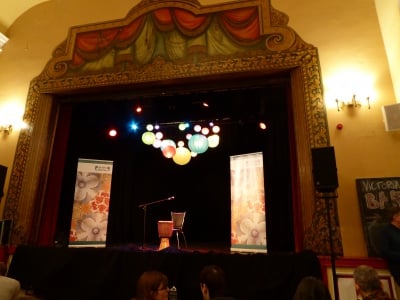Review: Martin Shaw, master mythteller
April 25, 2016

Photo used under creative commons licence
Martin Shaw is a storyteller, pure and simple.
Recounting myths, with just his own presence, verbal invention and store of tales – with the occasional help of a drum – may seem like the very heart of what Settle Stories is about. However, this year’s festival promoted a more contemporary, political aspect to storytelling. With events including an audience founder of people-power group 38 Degrees, David Babbs, a dramatisation of the murder of Alexander Litvinenko and a talk on the construction of national narratives, there seemed to be an effort to make storytelling ‘relevant’ to the modern world. Compared to this, the simplicity of Shaw’s performance and the antiquity of the stories he relates might initially seem out of step with the 2016 festival.

However, even toward the end of the festival’s second day, there’s an air of anticipation as the town’s Victoria Hall fills almost to capacity. When Shaw emerges – jacketed, hatted and full of beard – he embodies that mythic quality himself, looking almost as if he has stepped out of a Tolkien movie adaptation. He sets up a simple rhythm on his hand-drum, explaining it as the hoof-beat of a horse, cantering through the progress of the story, before settling down to treat us to two tales on the theme of daughters.
He starts with the ancient Nordic story of Tatterhood. A king and queen cannot have children, until a beggar-woman advises the queen to bathe, pour the bathwater on the ground and place the marriage bed over it. Come the morning, there will be two flowers, one red the other white, beneath the bed, of which she must eat only the white. This being a myth, rather than a moral fable, of course the queen eats the red flower as well as the white, and gives birth to Tatterhood – an ugly child, born riding a goat, waving a spoon and demanding meat – as well as a demurely pretty daughter.
Shaw injects some grace notes of modernity into his story-telling, referencing Joni Mitchell and Johnny Cash, describing the adventures of the sisters as a ‘Thelma and Louise situation, and according Tatterhood rock star status as she journeys north, telling stories as she goes. Part of this is tailoring the material to the audience, most of whom are of an age to appreciate the references. However, there is also a strong element of demonstrating the timeless appeal of the stories, given the ease with which they can be fitted into changing contexts.

The second story is the Arthurian myth of Sir Gawain and Lady Ragnelle, a version of a tale most familiar to English students as that of the Wife of Bath in Chaucer’s Canterbury Tales. Just as the first story culminated with Tatterhood revealing to her husband-to-be the questions that women want to be asked, so this story hinges upon the discovery of what women want (spoiler: it’s “sovereignty offered, sovereignty received, sovereignty returned”), and in both cases, the ostensibly unattractive woman’s true beauty is discovered once the secret has been revealed.
Shaw tells how the night’s stories “chose him”, in that he only realised the strong connections between them in the telling. He describes both of the stories as ancient, and suggests that each of them would originally have taken several days to tell. This is storytelling – pure and simple – at its best, and it is absolutely what the Settle Stories festival is about, and it’s hugely appreciated by its audience. However, perhaps the message embedded in both stories, about gender equality and mutual respect, shows that politics has been part of storytelling, and has shaped and been shaped by the narrative art, ever since once-upon-a-time.
Martin Shaw’s website is http://www.schoolofmyth.com/. Details of future Settle Stories events can be found at http://www.settlestories.org.uk/.

Comments